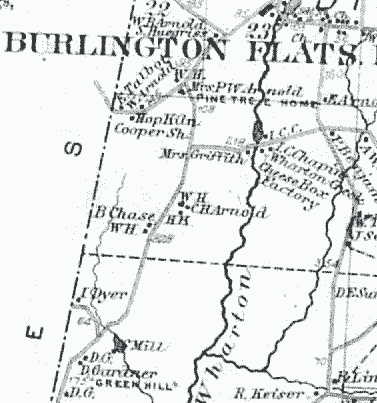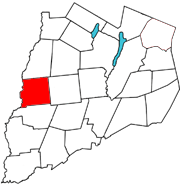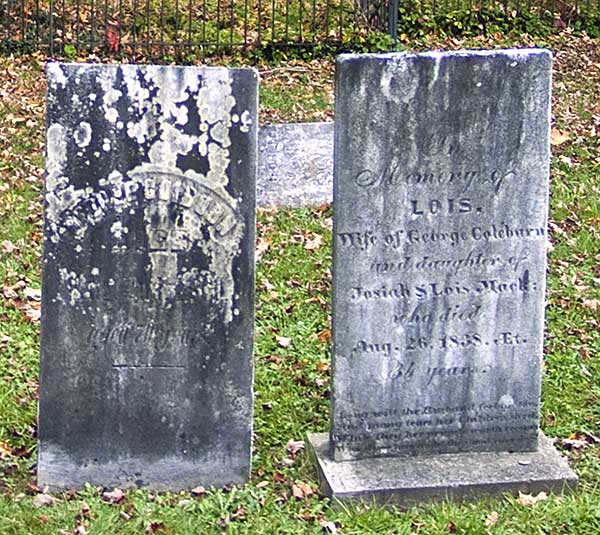Generation X: George Loses the Farm
Of the eight children of Ellis and Betsey, only one was a boy. George E. Colburn was born in 1799 in Plainfield and died in 1864 in Burlington Flats. Although he seems to have started out well enough, at some point George’s life seems to have gone off track.
In April 1822, at age 23, he bought a three-acre property for $550 in Burlington, “bounded...on the south by the highway leading from Peter Goodhill’s Mills to Nicholas Parker, on the west by land Belonging to Ellis Colburn...” The size and relatively high price suggests that this was not a farm but a place to house a family in town. The year following, 1823, he married Lois Mach (1804-1838.) She bore him eight children over the next 15 years, seven of which survived her. Her last, Delos, was born the year she died, so she may have died in childbirth.

The 1830 census lists the 30-40 year-old George living with a woman aged 20-30 (his wife Lois), four boys under 10 (George M, Josiah, Elijah, Albert) and a girl 10-15, perhaps a servant or sister.
By 1831 George seems to have saved enough money to buy a farm of his own, also in Burlington, for $2200. It seems to have been prime bottom land along a creek, just outside town:
containing one hundred and fifty eight acres one fourth of an acre of land be the same more or less, bounded as follows to wit: Beginning at a pile of stones in the south line of land owned by Freeborn Matterson and runs from thence southerly along the line of marked trees twenty six chains and forty one links to a stake and stones which is a corner between Samuel Gardners farm and the one hereby conveyed and on the east line of land owned by Amanda Dyer thence easterly on the north line of Samuel Gardner and lands formerly owned by Job Burleson deceased sixty four chains and fifty links to a small Butternutt tree on the west shore of the Wharton Creek. Thence up said west shore of said creek as it winds and turns till it strike the south east corner of lands formerly owned by Andrew Matteson and now owned by Elijah Chapin.... Ref

From the Burlington page of the 1868 atlas of Otsego County. Ref
In 1868 a farm on the west bank of Wharton Creek had the same neighbors (Dyer, Gardner, Chapin) named in the 1831 George Colburn deed. A family named Arnold lived there then - the Colburns were long gone. After only two years on the farm next to Wharton Creek, in November 1833, George and Lois sold the property for $3000 (making a tidy profit, it would seem, of 36%.) Shrewd assessment of land values was a key skill in those days, according to Alan Taylor:
In their commercial, competitive, agricultural, and rapidly expanding society, men prospered or failed largely on the basis of their ability to judge and acquire superior lands.... The farmer who correctly gauged the long-term fertility of a tract was more apt to prosper than one who paid too much for an inferior farm... Ref
In 1839, a year after Lois died, George married Sally Ann Medbury (1801-1885.) Sally Ann came from a numerous clan of Medburys that had migrated from Rhode Island to the New Lisbon area around the turn of the 18th century. New Lisbon lay just across the Unadilla river in Chenango County. Sally Ann was 37, very late in life for a woman's first marriage in the 19th century. In 1840 she bore George one more child, Legrand (the first Colburn to be given that name, though not the last.)

The 1840 census lists George living with his second wife Sally Ann and seven surviving children, now in the town of Pittsfield. Unlike his father, George had almost all boys. Three others live with them, two female and one male, likely employees.
The mark for the male appears in the 10-24 age bracket of Free Colored Persons. “Colored Persons” were extremely rare in Otsego County at the time (and are still rare there today.) According to Wikipedia “Upstate New York became a major center of radical abolitionist activity and was an important nexus of the Underground Railroad.” Perhaps this young man live with the Colburns as the result of such activity.
Sally Ann's Cousin Takes the Farm
George’s real estate astuteness, or luck, did not hold out on his next deal, made a few months after selling his farm in Burlington. On February 1, 1834 he bought a slightly smaller property in the neighboring town of Pittsfield for $2244, from a couple named Ostrander (farms seem to have changed hands either late autumn, after harvest, or just before spring planting.) Hiram Ostrander was a "Yorker," descended from a Dutch family that first arrived in New Netherlands in 1660.

The town of Pittsfield, Otsego County, NY
Far from his Yankee father’s beginnings on Plainfield Hill, George now had a large farm right on the Unadilla River:
being the north parts of lots number sixty-seven and seventy-six in the Hillington tract and bounded as follows: beginning at a beach tree on the east side of the Unadilla River marked 1780 at the southwest corner of Gratz’s tract thence along the south line thereof sixteen chains and ten links to a hemlock stake marked, thence south fifty five chains to a hemlock marked. Thence west twenty four chains and fifty links to the said river thence up the river as it winds and then to the place of beginning containing one hundred and thirty six acres of land by the same more or less… RefThis is good riverbottom farming land, still cultivated in the early 21st century (unlike the hill plots where his father and uncles homesteaded, which have reverted to forest.) In a 1903 atlas, prosperous farmers could pay to have their farm featured. One neighboring farm's blurb reads:
Dairying and fine crops of oats, potatoes and corn have made Hill Homestead a valuable property. Able management has had something to do with this...

From New Century Atlas of Otsego County NY, 1903. George Colburn's farm is likely where W(illiam) A. Medbury's appears.
What happened to George Colburn? The 1840 census seems to show him a prosperous landowner, with numerous young sons and a new wife from a clan of prosperous merchants. Three others live under his roof, presumably working for him. By 1844 however the dream seems to have fallen apart. The only clues to what happened appear in real estate records.
The Yorkers who sold George the Pittsfield farm apparently took out a mortgage with New York Life Insurance in 1832. There is no mention of the mortgage in the 1834 sale document, despite the Ostranders’ assurance that they “have in themselves good right full power and lawful authority to grant and convey...” By 1844, $920 was still owed. Whether or not George Colburn knew about the Ostrander mortgage when he bought the Pittsfield property, he took out another one himself in January 1841. At some point he also bought an additional 41 acres in the same area.
The owner of the 1841 mortgage, who also at some point bought the 1832 mortgage from New York Life, was one Samuel Medbury, first cousin once removed of George’s second wife Sally Ann. Samuel was something of a mover and shaker in New Berlin, owning real estate worth $15,000 in 1850, according to the census. After the financial panic of 1857 he moved to Michigan, where he successfully started several businesses.
In November 1844 a notice was published that the Pittsfield farms owned by the Colburns would be put up for sale, the following February, to satisfy a debt of $3456.66.
...the mortgager and all other persons having him on said premises subsequent to said mortgage were duly served with said notice and Whereas the said party of the second part duly became the purchaser at such publick auction of the said premises for the price of thirty five hundred dollars after the notice aforesaid had been published in the manner aforesaid for the time required by law now therefore the said George Colburn and Sally Ann his wife the said parties of the first part in consideration of the promises noted and of the sum of one dollar to them in hand paid by the said party of the second part the receipt-whereof is hereby certified do hereby grant bargain and sell assign and convey to the same party of the second part his heirs and assigns forever All and singular the aforesaid premises with the appurtenances to have and to hold to him and them to his and their care own proper use forever in fee simple In witness whereof the said parties of the first part have hereunto set their hands and seal the day and year first above written.
George Colburn Sally A. Colburn Ref
It must have been a humiliating scene: Sally Ann’s cousin giving the couple a single dollar in exchange for all their land. In the 1850 census Samuel's brother Charles begins to appear in the census, as owner of a farm in Pittsfield worth $1500. That farm appears in the 1903 atlas under the name of his son, William A. Medbury.

Satellite image, 2011. The Unadilla River meanders more than in 1903, and briefly forks near where the George Colburn farm once was. Bright areas have been recently plowed.
Was George a victim of bad lawyering--tricked by the Yorkers who sold him an attractive farm into unwitting responsibility for an unsustainable mortgage? Or, trained by his father in the ways Yankee farmers made the best of hilly terrain, was he unable to cope with the different demands of the better bottomlands long farmed by Yorkers? Perhaps he was unlucky enough to purchase his riverine lands just before a flood. The Unadilla is prone to flooding in places, and today briefly splits into two channels near where his farm used to be, in a way that does not appear in the 1868 or 1903 maps.
George Colburn reappears in the census records of 1860 as head of a household living in New Berlin with Sally Ann, daughter Melissa, son Legrand, Legrand's wife Louisa, and a domestic. He is listed as having personal property valued at $1000, but no real estate. Perhaps he was tenant farming one of Samuel Medbury's properties.

George Colburn family in the 1860 census records for New Berlin, Chenango County
George might have had moral or psychological issues. There was a lot of drinking on the American frontier, often to excesses that inspired the Temperance movement during his lifetime. His business reversal might have sent him into what at the time was called "melancholia" and today "depression" (an affliction not unknown among his descendants.)
When George’s father Ellis wrote his will in 1858, he left $100 to each of George’s children, 1/4 of his real estate to each of four surviving daughters, and everything else to his eldest daughter Cynthia. To George, his only son, he left nothing.

Excerpt from a copy of Ellis Colburn's will, in which he left $100 (about $2800 in 2014 dollars) to each of his son George's children but nothing to George himself.

GEORGE COLBURN
Died
August 2, 1869
aged 70 years
In Memory of
LOIS.
Wife of George Coleburn (sic)
and daughter of
Josiah & Lois Mack
Who died
Aug. 26, 1838. Et.
34 years
Long will the Husband feel his loss
And many tears her Children shed
While they her private worth recall
Who sleeps here midst the slumbering dead
A sad indication of how George was thought of at the end of his life can be observed in the condition of his tombstone. His marker has weathered the years poorly compared to that of his first wife Lois, on the right, who predeceased him by thirty years. It must have been made of cheaper stone. Hers has a small base; his has none. Both are quite simple and deeply weathered compared to the handsomely carved, sturdy stones marking the graves of his parents and sisters in the same plot in the Burlington Flats cemetery.
George’s second wife Sally Ann, who lived on another twenty years, is buried with her parents across the river in New Berlin. In the 1870 census, one year after George's death, she is listed as living with a retired farmer named Harris, employed at age 69 as a domestic.
Whatever the nature of George's problems, he and his two wives produced many sons who carried on the name Colburn. The story of the third, Elijah, will be taken up in the next chapter.
GEORGE E. COLBURN
born 1799, Otsego County, NY
died Aug 2, 1869, Burlington Flats, NY
married 1. circa 1823 Lois Mack
d/o Josiah & Lois Mack, Burlington Flats
children
George M b 1824
Josiah
ELIJAH 1827-1879
Albert b 1828
Nelson b 1832
Melissa b 1834
Delos b 1838
married 2. circa 1839 Sally Ann Medbury 1800-1885
d/o Stephen Medbury & Tabitha Angell
children
Legrand b 1840